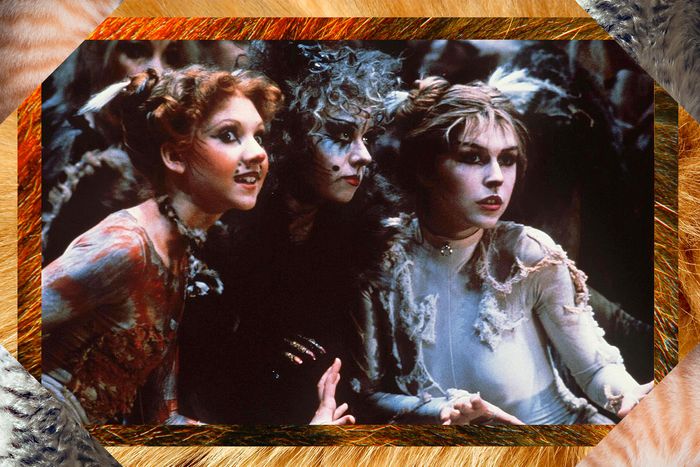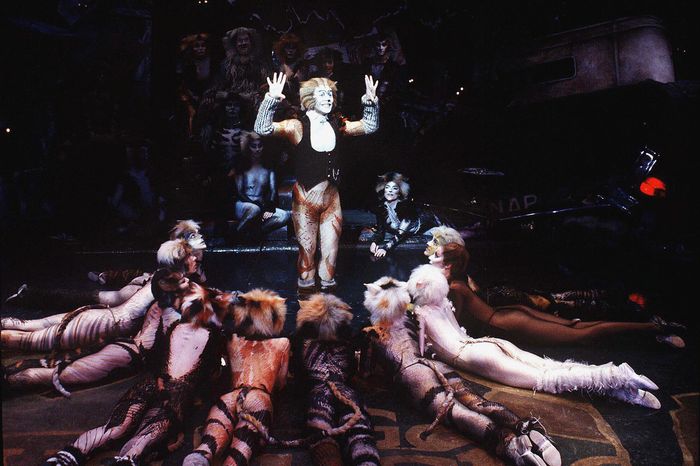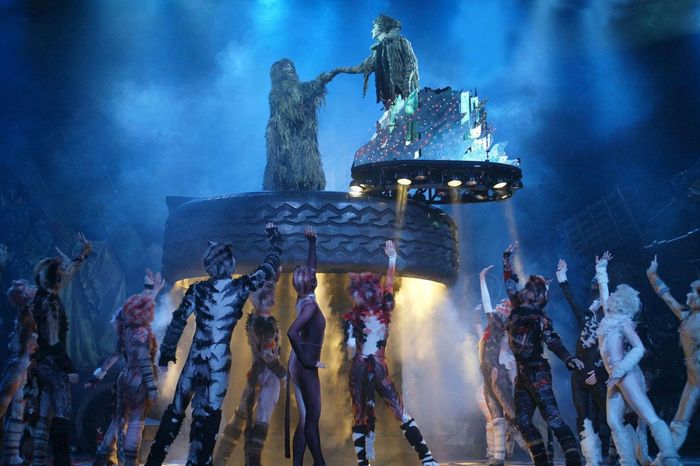
The first thing you need to know about the musical turned movie spectacular Cats is that it’s about cats. The second is that they’re not really cats. The third is probably that it involves a sort of ritual sacrifice and rebirth. The fourth is that there really isn’t much of a plot anyway. I’m sorry, this is already getting confusing, but that’s just how things work with Cats. It’s total nonsense. It defies explanation. Yet, it’s still my job as a web journalist to try to explain difficult cultural concepts. So, in the interest of making sure that you go into this winter’s movie-musical spectacular as well prepared as possible, I’ll try to answer all the questions you have about the deranged universe of Cats.
So they’re cats?
Yes, and no. The musical Cats, created by Andrew Lloyd Webber with director Trevor Nunn and choreographer Gillian Lynne, is based off of the poems in T.S. Eliot’s Old Possum’s Book of Practical Cats, which he originally wrote to amuse his godchildren. The poems are silly, extremely British, and not that much like the works typically associated with T.S. Eliot, the literary giant (who also was antisemitic, we should just note) behind The Wasteland or The Love Song of J. Alfred Prufrock, which you may have talked about in school.
In one of those poems, “The Song of the Jellicles,” Eliot describes a class of “Jellicle Cats” that have special attributes, and which are the main characters in Cats. They “are black and white,” “are rather small,” “develop slowly,” “are roly-poly,” like to dance “by the light of the Jellicle Moon.” So basically, they’re all an especially human tribe of cats, with specific personalities and also a little bit of a magical air. Most importantly, they all gather for a “Jellicle Ball,” which is the central event in Cats.
What the hell does “Jellicle” mean?
According to T.S. Eliot’s widow Valerie Eliot (at least as described in Lloyd Webber’s memoir), the word comes out of T.S.’s private joke about how the British upper class slurred the words “dear little cats” together to somehow make a sound like “Jellicle.” Eliot also wrote about “Pollicle Dogs,” based off the phrase “poor little dogs.” There’s a poem, “The Aweful Battle of the Pekes and the Pollicles” that gets ported into Cats, where the cats all dress up as dogs and make fun of them. This is frankly anti-dog, but what did you expect in Cats?
So the cats are cat-size?
Yes, the cats in Cats are and have always been the size of actual cats. The musical all takes place in a stage fashioned to look like a junkyard, with oversize trash that makes the human actors look small. The movie will apparently have the cats wander around various sets in a fake London.
Okay, back to the Jellicle Cats. What makes them special?
As Eliot discusses in “The Naming of the Cats” (which became the creepiest song in Cats) all the Jellicle Cats have three different names: the one that a human family uses, the one that is particular to each and “never belong to more than one cat” (think Munkustrap, Quaxo, or Coricopat), and then a third supersecret name that “no human research can discover” but “THE CAT HIMSELF KNOWS.” To go with their names, all the Jellicle Cats in Cats have specific attributes and positions within the tribe.
Who are the key cats in Cats?
There are … so many cats, but if you’re watching the movie, you pretty much only need to care about Old Deuteronomy, the cat in charge (Judi Dench); Grizabella, the fading glamour cat (Jennifer Hudson); Munkustrap, who acts as the narrator (Robbie Fairchild); Rum Tum Tugger, the sexy cat (Jason Derulo); Macavity, the dangerous mystery cat (Idris Elba); Bombalurina, a flirty cat who sings about Macavity (Taylor Swift); Bustopher Jones, the rich cat (James Corden); Jennyanydots, the lazy cat (Rebel Wilson); Mr. Mistoffelees, the cute magical cat (Laurie Davison); and Gus, the theater cat (Ian McKellen). Gus, notably, used to fantasize about one character he played as a young actor in a whole set-piece called “Growltiger’s Last Stand,” but they axed that in the recent Cats revival, which is good because it was racist. Dangers of working off of T.S. Eliot.
Most of the characters in Cats also appear in Old Possum’s, but Lloyd Webber and his collaborators also raided Eliot’s unpublished poems for ideas. From there, they got the idea for Grizabella (a.k.a. the one who sings “Memory”), as well as the Jellicle Ball, an event Eliot described in a letter as the time when the Jellicle Cats and Pollicle Dogs go up to the “Heaviside Layer” in an air balloon. In Cats, instead, the Jellicle Ball becomes a yearly event where all the cats get together and decide to send just one cat up to the Heaviside Layer, which adds drama to the thing.
Wait, like ritual sacrifice?
Pretty much. The implication in the show becomes that the cats are all auditioning for Old Deuteronomy — the oldest and wisest cat, usually played by a man but played by Judi Dench in the movie — in order to be chosen to be sent to the Heaviside and reborn into a new life. Technically that’s more of a mystical rebirth than a sacrifice, but we only ever see Grizabella (spoiler alert, she wins because she sings “Memory”) go up on a big tire at the end of the show, so who knows if she ever comes down.
So it’s all a Christian death and resurrection metaphor?
Sure.
Just in time for a Christmas release?
Maybe this is why they put “you will believe” on the first poster. Just kidding, that will never make sense.
What’s the Heaviside Layer?
Just a random part of the atmosphere that, I assume, Eliot thought sounded cool! According to Wikipedia, the Kennelly–Heaviside Layer “is a layer of ionised gas occurring between roughly 90 and 150 km (56 and 93 mi) above the ground — one of several layers in the Earth’s ionosphere.” It’s named after the scientist Oliver Heaviside, so despite how it sounds, it has nothing to do with weight, and it’s a layer not a lair, even if the latter seems more like something that would involve cats.
So the lyrics are all just T.S. Eliot poems?
Pretty much, even if a lot of them are refigured to make it all work. For instance, consider the big Cats earworm “Memory.” While they were working on the musical, Lloyd Webber and Nunn realized they needed a big song to sell the show, and put on the airwaves. Lloyd Webber pulled up a tune that he’d originally written for a musical that was going to be about Puccini and Leoncavallo’s rival versions of La Bohème (which is why “Memory” basically sounds like a knockoff Puccini aria), and Nunn suggested using Eliot’s “Rhapsody on a Windy Night” for the lyrics, which he adapted for the show. Webber’s frequent collaborator Tim Rice also tried his hand at a rewrite of the “Memory” lyrics, but his version didn’t end up being used. Point is, if “Memory” sounds jarringly out of place, there are reasons why.
Is the movie going to change the plot of Cats?
I don’t know! Nobody has seen it yet. But going off of the most recent trailer, it looks like there are two major changes: First of all, the cats have dialogue now, which never happened in the musical and frankly destroys the entire trancelike experience of watching Cats.
Secondly, Victoria the White Cat, a young cat who gets a whole balletic dance in the musical but not her own song, is positioned as the lead of the movie. She’s played by Francesca Heyward, and she’ll also sing the new Taylor Swift song in the movie. My guess is that Universal wanted an audience-surrogate figure, and so we’ll follow Victoria on her first journey to the Jellicle Ball as she meets all the Jellicle Cats one by one, runs into trouble with Macavity, and then witnesses Grizabella’s big journey up to the Heaviside Layer. But really, anything could happen in this movie. It’s Cats.
Wait, before you go, why do people like Cats?
That’s not for me to answer. I’m a dog person.
More From This Series
- Cat Performances, Ranked
- Watch Cats With Us on Instagram Tonight … Please
- Cats Flopped and Then Things Got Interesting




